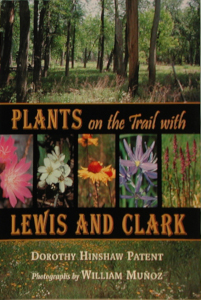Plants on the Trail with Lewis and Clark

Author:
Dorothy Hinshaw Patent
Photographer:
William Muñoz
Publication:
2003 by Clarion Books
Genre:
History, Nature, Non-fiction
Pages:
104
Current state:
This book has been evaluated and information added. It has not been read and content considerations may not be complete.
Book Guide
Search for this book used on:
"The plains of this country are covered with a leek-green grass.... Groups of shrubs covered with the most delicious fruit are to be seen in every direction, and nature appears to have exerted herself to beautify the scenery by the variety of flowers." —William Clark
When President Thomas Jefferson sent Meriwether Lewis and William Clark on an expedition in 1804 to explore the Louisiana Territory and then continue to the Pacific Ocean, their goals were to find a water route across North America, meet with Indian tribes and discuss peaceful trade, and map and describe this unknown region. Jefferson also instructed them to notice "the soil and face of the country, its growth and vegetable productions."
Along their route, the explorers, known as the Corps of Discovery, collected and described nearly two hundred species of plants, from small prairie flowers to towering evergreen trees. Many were previously unknown to science. Lewis already possessed a strong interest in and knowledge of plants, and from the Indians they encountered he learned much about their uses as food and as building materials, as well as their healing properties. The plant Lewisia (more commonly known as bitterroot) and the beautiful ragged robin, or Clarkia, were later named after the explorers themselves. Lewis and Clark are now recognized as central figures in the country's westward expansion and as major contributors to its scientific scholarship.
Dorothy Hinshaw Patent and William Munoz's latest collaboration examines the rich array of plant life encountered by Lewis and Clark. Nature lovers and historians alike are sure to be captivated by this visual feast.
From the dust jacket
To view an example page please sign in.
Please sign in to access the type of illustrations and view more books with this type.
To view companion books please sign in.
Content Guide
Please sign in to access all of the topics associated with this book and view other books with the same topics.
Please sign in to access the locations this book takes place in and view other books in the same location.
Please sign in to access the time periods this book takes place in and view other books in the same time period.
Find This Book
Search for this book used on:


